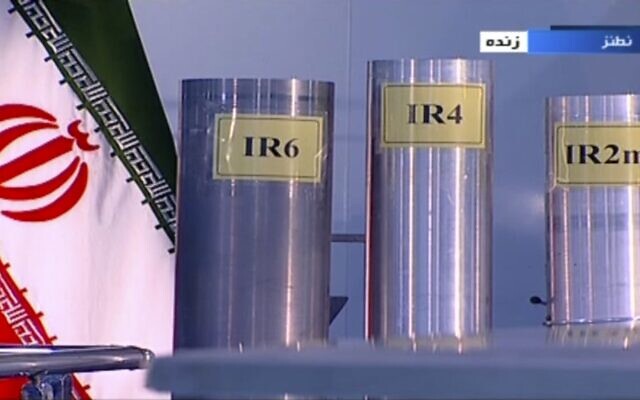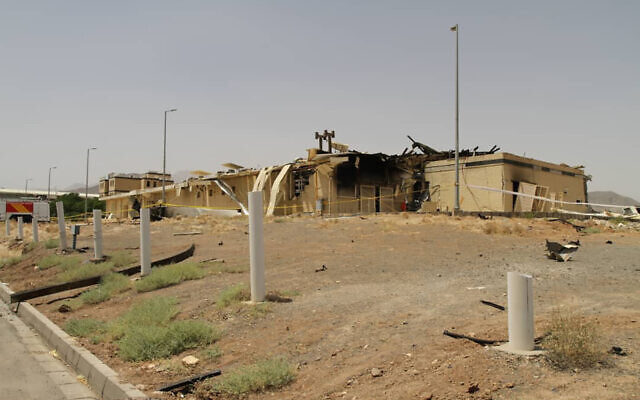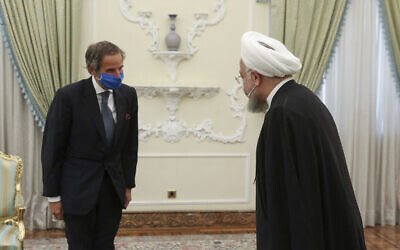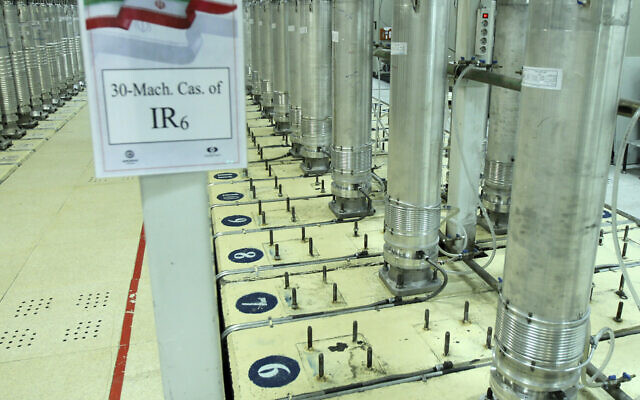Leaked atomic watchdog report says Iran has installed 174 highly advanced IR-4 machines at underground site in further violation of nuclear deal, and plans on installing more

Iran has begun using the highly advanced new IR-4 centrifuge to enrich uranium at its Natanz plant in a further breach of its commitments under the 2015 nuclear deal, the Reuters news agency reported Tuesday, citing a UN atomic watchdog document.
Washington pulled out of the JCPOA (the Joint Comprehensive Plan of Action) unilaterally in 2018 under then-president Donald Trump, but President Joe Biden has indicated that the US would be willing to rejoin.
Iran has been steadily violating the restrictions of the deal, including on the amount of enriched uranium it can stockpile and the purity to which it can enrich it. Tehran’s moves have been calculated to put pressure on the other nations in the deal — Russia, China, France, Germany and Britain — to do more to offset crippling sanctions reimposed under Trump, but they also bring Iran potentially closer to the bomb.
Last year, Iran began enriching uranium in its underground Natanz plant with a second cascade, or cluster, of IR-2m centrifuges. The deal only lets it enrich there with first-generation IR-1 machines.
Now, the Iranians have also started using the IR-4 centrifuge, the International Atomic Energy Agency said in a report to members obtained by Reuters.
“On 15 March 2021, the Agency verified that Iran began feeding the cascade of 174 IR-4 centrifuges already installed at FEP with natural UF6,” the IAEA said, referring to uranium hexafluoride, the form in which uranium is fed into centrifuges for enrichment.
The report said Iran also planned to install a second cascade of IR-4 centrifuges.
The IR-4 and IR-2 models are believed to have an enrichment output at least four times greater than the IR-1.
“In summary, as of 15 March 2021, Iran was using 5,060 IR-1 centrifuges installed in 30 cascades, 522 IR-2m centrifuges installed in three cascades and 174 IR-4 centrifuges installed in one cascade, to enrich natural UF6 up to 5% U-235 at FEP,” the IAEA report said, referring to the fissile purity of uranium.

Natanz is Iran’s main nuclear enrichment plant. An explosion at the site last year, which foreign media reports have attributed to Israel or the US, damaged an advanced centrifuge development and assembly plant.
Iran said in January it planned to install 1,000 new centrifuges at Natanz within three months and that its scientists had exceeded previous goals for uranium enrichment.
Also in January, Tehran announced it was beginning to enrich uranium up to 20 percent at the Fordow plant — far beyond the 3.5% permitted under the nuclear deal, and a relatively small technical step away from the 90% needed for a nuclear weapon. Iran also said it was beginning research into uranium metal, a material that technically has civilian uses but is seen as another likely step toward a nuclear bomb.
Iran insists it is not seeking to develop nuclear weapons, but Israel has accused Tehran of having covertly worked toward a bomb in the past, and claims the regime continues to advance a rogue nuclear weapons program. Israel’s Prime Minister Benjamin Netanyahu has urged Biden not to reenter the 2015 JCPOA unless its provisions are widened and stiffened, and has vowed that Israel will do whatever is necessary to prevent Iran from attaining nuclear weapons.
The news regarding the IR-4 centrifuges came after the IAEA chief told European lawmakers on Tuesday that a US return to the 2015 nuclear deal with Iran remains possible, but both sides need to be prepared to negotiate.

Iran has said that before it resumes compliance with the deal, the US needs to return to its own obligations under the deal by dropping the sanctions.
Asked about Iran’s insistence that the US take the first step, International Atomic Energy Agency Director General Rafael Grossi said in a video appearance before three European Parliament committees that “it takes two to tango.”
He noted that over the past two years Iran has accumulated a lot of nuclear material and new capacities, and used the time for “honing their skills in these areas.”
“Even if you had a magic wand or the hand of God and said we go back tomorrow, there will be a lot of housekeeping,” he said.
Grossi said he had been talking to both sides in his agency’s “impartial neutral role” and did think that a US return to the deal was possible.
“They want to come back,” he said. “But of course … there are a number of issues that still need to be clarified. So it’s not impossible. It is difficult, but not impossible.”
The ultimate goal of the deal is to prevent Iran from developing a nuclear bomb. Iran now has enough enriched uranium to make a bomb, but nowhere near the amount it had before the nuclear deal was signed.
As part of its ongoing violations of the JCPOA, Iran last month began restricting IAEA inspections of its nuclear facilities.
Under a last-minute deal worked out in a trip to Tehran by Grossi, however, some access was preserved.

Under that temporary agreement, Iran will no longer share surveillance footage of its nuclear facilities with the IAEA, but it has promised to preserve the tapes for three months. It will then hand them over to the IAEA if it is granted sanctions relief. Otherwise, Iran has vowed to erase the tapes, narrowing the window for a diplomatic breakthrough.
“Admittedly it is limited, but it allows to maintain a record of the basic activities that are taking place,” Grossi said. “Granted it is not the same as the whole access that we used to have.”
Grossi said it was important for the JCPOA powers to use this three-month “diplomatic window of opportunity” that Iran has granted.
“In this time period, the parties involved will hopefully be able to achieve, or at least start to move back to the JCPOA,” he said.
As reported by The Times of Israel
